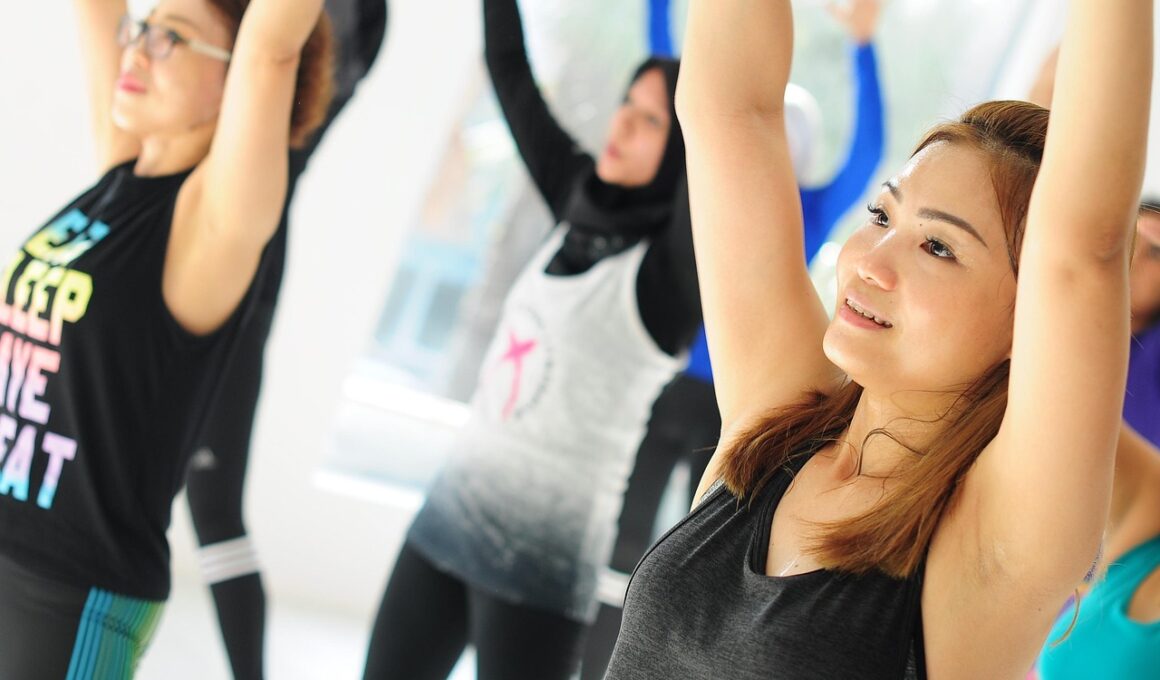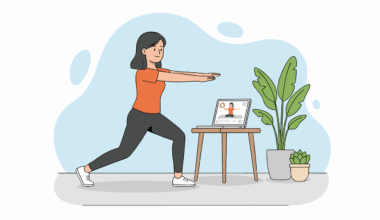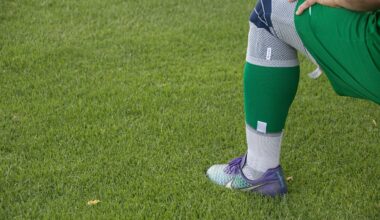The Future of Group Fitness in Sports Conditioning
Group fitness classes are rapidly evolving, particularly in the realm of sports conditioning. As technology advances, instructors and participants alike are embracing new methods that enhance performance and engagement. Innovations such as digital platforms and mobile applications have transformed the landscape of group fitness. These tools allow for tailored workout plans that cater to individual goals. Moreover, they support community building through social interactions among participants. By using data analytics and wearables, instructors can track progress and adapt workouts to optimize results. Furthermore, group fitness fosters a sense of accountability, motivating individuals to push their limits collectively. This synergy is vital in sports conditioning, where teamwork enhances athletic potential. Future developments in class structures are also promising, with flexible scheduling and hybrid models combining in-person and online options. This adaptability appeals to various lifestyles and ensures more participants can benefit from structured training. As we look forward, group fitness will likely emphasize inclusion and diversity, encouraging athletes of all levels to partake in these classes designed for rigorous conditioning and collective support.
Interactive and engaging formats are essential to keep participants motivated in sports conditioning. Incorporating elements such as gamification and competitive challenges increases the enjoyment factor significantly. Instructors may implement leaderboards, leaderboards to foster competition among participants while promoting camaraderie. Social media integrations can amplify this experience, allowing members to share achievements and milestones. These features not only enhance the fun but can lead to greater participant retention. Additionally, virtual reality technology may play a role in shaping the future of group fitness. This can provide immersive experiences that accurately mimic various sports scenarios. Conditioning routines can become playful and enjoyable, pushing participants out of their comfort zones. Personalization will also be paramount; customizing training regimens according to participants’ unique goals will ensure effective workouts. Moreover, the emphasis on functional training will continue to grow, helping individuals improve real-life skills alongside their fitness objectives. Such approaches can significantly enhance athletic performance and reduce injury risks. By integrating these practices, the future of group fitness in sports conditioning promises a vibrant, inclusive, and effective environment for all individuals.
Importance of Community in Group Fitness
The community aspect of group fitness cannot be overlooked, especially in sports conditioning. Being part of a group creates motivation, as individuals work together towards similar goals, fostering a supportive environment. This positive atmosphere encourages participants to push their limits and achieve personal bests during workouts. Instructors can play an influential role by cultivating a sense of belonging among participants. They can also create specialized workshops and events that foster community engagement. These might include skill clinics focused on specific exercises and team-building challenges that enhance team dynamics. Social interactions during training sessions promote emotional well-being, reducing stress and anxiety linked to physical activity. Furthermore, participants often develop friendships that extend beyond the gym, further solidifying community ties. The social bonds formed can enhance adherence to workout routines, leading to sustained success in sports conditioning. Local fitness communities also provide avenues for charitable events and activities, creating shared objectives that reinforce bonds. In summary, strong community dynamics within group fitness classes are essential for participants, resulting in holistic enhancements in performance and motivation throughout their conditioning journey.
Technology will continue to play a pivotal role in shaping the future of group fitness classes in sports conditioning. Innovations such as artificial intelligence and personalized apps make training sessions more efficient and engaging. These technologies can analyze participant performance data and recommend specific adjustments to improve results. Moreover, they enable trainers to provide real-time feedback, enhancing the overall experience for participants. As virtual classes gain popularity, they allow individuals from diverse locations to unite in pursuit of shared goals. This broader reach enables a fusion of ideas and techniques from various fitness cultures, enriching overall training programs. Technology will also facilitate continuous education for instructors, allowing them to stay informed on the latest techniques in sports conditioning. Additionally, health research becomes more accessible, informing evidence-based practices that improve class effectiveness. Continuous advancements in fitness wearable technologies ensure participants can accurately measure their progress and set achievable milestones. As a result, participants become more proactive in their fitness journey. By embracing these technological changes, group fitness classes will likely become more accessible, inclusive, and tailored to individual needs, maximizing efficacy and enjoyment throughout the fitness spectrum.
Future Trends in Group Fitness
Future trends in group fitness will likely emphasize hybrid training models merging physical and digital experiences. As the industry adapts to consumers’ preferences, the flexibility of training formats will become crucial. These may include live stream classes alongside in-person sessions, catering to varied lifestyles while expanding participants’ access. The concept of “bring your gym home” could encourage equipment manufacturers to develop smart devices tailored for personalized workouts. Moreover, fitness facilities may invest in creating adaptable environments for different training methods. The integration of social experiences into workouts will likely escalate, including unique themed classes that create excitement and enthusiasm. Workshops focused on nutrition, mental resilience, and recovery alongside fitness instructions may also emerge. This holistic approach provides a well-rounded understanding of sports conditioning. As individuals grow more conscious of their health, demand for sustainable gym practices is on the rise. Facilities will prioritize eco-friendly equipment, materials, and practices to appeal to environmentally aware consumers. Overall, the fitness industry is transitioning towards greater adaptability, sustainability, and comprehensive care, ensuring that group fitness classes have a bright future in the realm of sports conditioning.
Instructor training and development will remain critical in shaping the future of group fitness classes in sports conditioning. Fitness professionals must consistently pursue continuing education to stay current on exercise science advancements and coaching methodology. Regular workshops, certifications, and conferences provide opportunities for enhancive learning experiences tailored to ensure effective management of diverse class dynamics. Additionally, instructors must be well-versed in modifying exercises for varying fitness levels, ensuring inclusivity within their classes. Emphasizing soft skills, such as communication and empathetic leadership, is also vital. Understanding the unique needs and goals of participants allows instructors to foster a supportive and motivating environment. The role of mentorship within fitness communities should not be underestimated, as experienced trainers can guide aspiring professionals. This collaboration facilitates knowledge transfer, promoting an exchange of expertise benefitting both instructors and participants. As group fitness classes evolve, so too will the expectations placed on instructors in their quest to amplify results and foster community engagement. The future demands skilled leaders who are adaptable, knowledgeable, and passionate about helping others achieve their fitness goals within sports conditioning.
Conclusion and Vision Ahead
As we look ahead, the future of group fitness in sports conditioning is teeming with opportunity. The evolving landscape presents endless possibilities for innovation, personal connection, and progress. Participants can expect elevated experiences supported by technology that enhances accountability and engagement. Creating an inclusive and diverse atmosphere will be paramount, empowering individuals at all fitness levels to discover their strengths. The integration of community-building practices will fortify motivation and resilience, impacting not only physical results but also emotional wellbeing. Instructors will continue to play a vital role in these developments, focusing on continuous growth and skill enhancement to meet participant needs. Strengthening bonds within the group will ensure participants feel understood and supported during their conditioning journeys. Regulations surrounding health and safety will also adapt to support evolving expectations while creating sustainable environments for fitness practices. By staying ahead of these trends, the group fitness industry can harness technology, inclusivity, and community-building—creating a powerful framework for future sports conditioning. With strategic collaborations and feedback from participants, the path is clear, ensuring group fitness provides transformative experiences for all involved.
The ongoing evolution in group fitness classes emphasizes the greater accessibility, engagement, and personalization in sports conditioning. By embracing innovative techniques and fostering community dynamics, these classes can revitalize the overall fitness experience. As this sector continues to grow, it will become increasingly vital to engage professionals and participants alike in shaping the future of group fitness.


